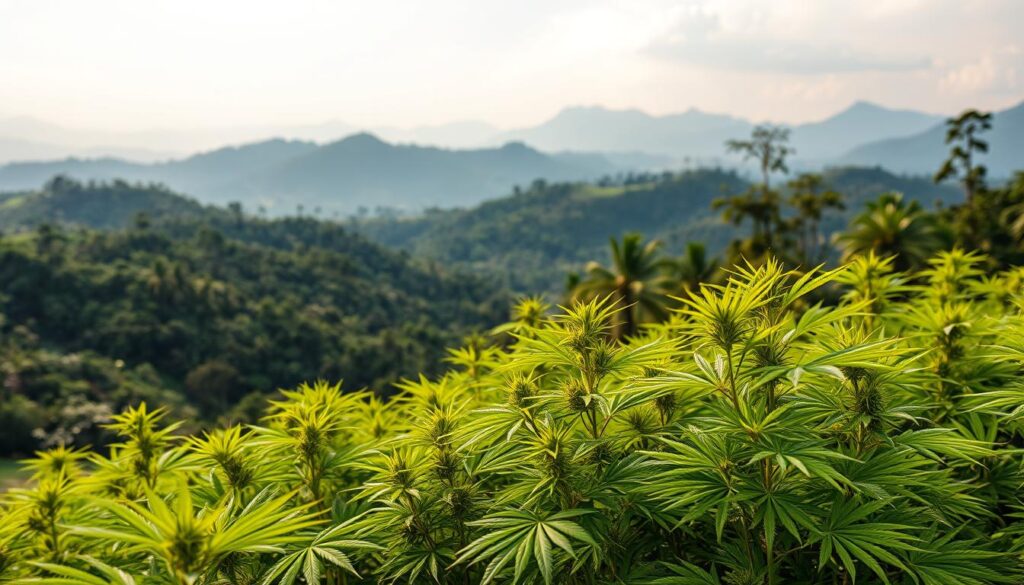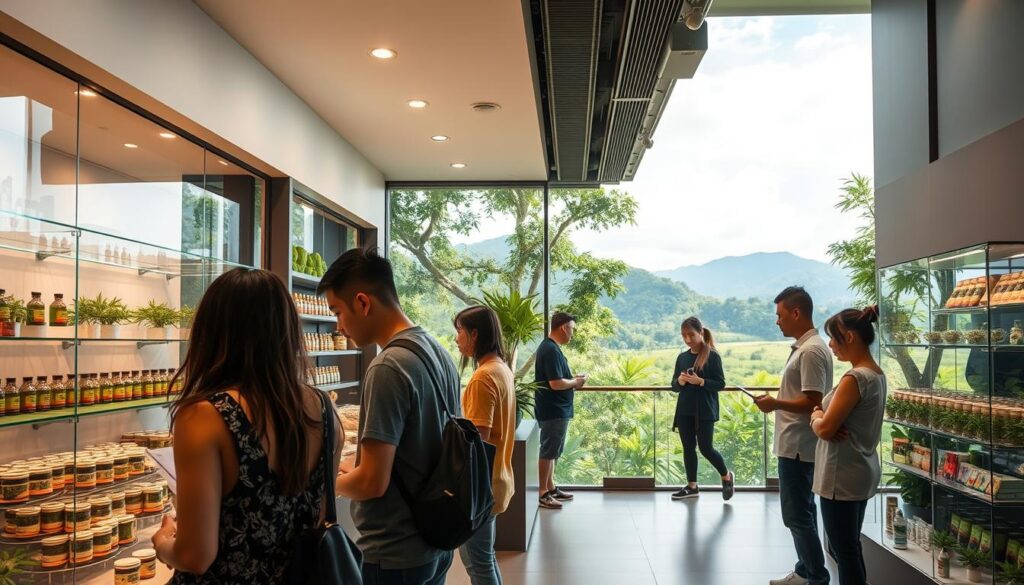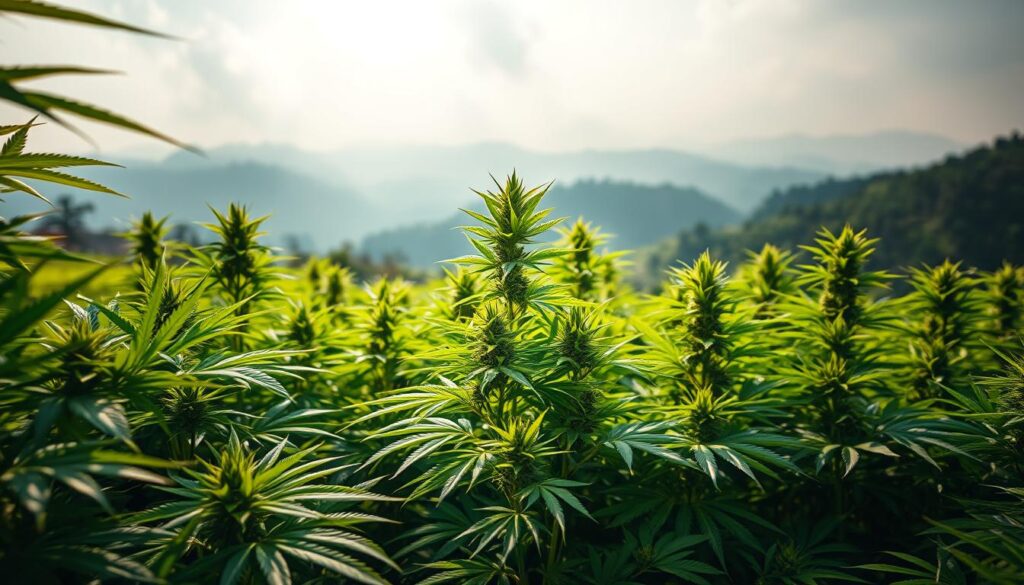Sarawak’s rainforests and culture make it special for plant lovers. Some plants are very important here. This guide will tell you about them, mixing old traditions with new times.
In Sarawak, plants and people have a long history. Communities have used plants for ages. But, it’s important to follow the rules and respect the plants and people.
Key Takeaways
- Sarawak’s biodiversity supports unique plant species with cultural and historical value
- Traditional uses of local flora remain intertwined with indigenous knowledge
- Legal frameworks surrounding certain plants require careful navigation
- Market developments are influencing availability and public perception
- Responsible exploration prioritises sustainability and cultural sensitivity
If you love plants or just want to learn, this guide is for you. We’ll explore Sarawak’s plants together. We’ll do it with respect for the local ways and laws.
Understanding the Legal Landscape of Weed in Sarawak
Knowing the laws about weed in Sarawak is very important. What you don’t know can lead to big trouble. It’s key to understand how laws affect your choices and why knowing them is crucial.
Legislation Overview
The Dangerous Drugs Act 1952 in Sarawak makes it illegal to have, grow, or sell weed. If you break these rules, you could face:
- At least 5 years in jail for having weed
- Up to RM 20,000 (£3,100) in fines for first-time offenders
- Being forced to join rehab programs if you get caught again
Trying to buy weed online is just as bad as buying it in person. The police watch online deals closely. In 2021, 63% of drug arrests were from social media.
Recent Developments
In 2022, the laws got even tougher:
| Change | Before 2022 | After 2022 |
|---|---|---|
| Possession Fines | RM 10,000 | RM 20,000 |
| Online Sale Penalties | 5-year max | 10-year max |
In 2023, more people were charged with weed crimes, with 72% of cases in Kuching. Places outside cities had fewer arrests but bigger fines compared to what people earn.
Consequences of Illegal Possession
There are big differences in how cases are handled:
“My client got a 7-year sentence for 15g found in Kuching – cases in rural areas often get better deals.”
First-time offenders in cities get hit harder than those in rural areas. Now, border checks use new scanners to find weed. So, trying to buy weed online is very risky.
Types of Weed Available in Sarawak
Sarawak’s cannabis scene is a mix of local and global. You can find earthy local strains or sleek hybrids. Let’s look at what’s grown here and what comes from abroad.
Local Strains: Borneo’s Botanical Treasures
Sarawak’s climate creates unique cannabis. The Sarawak Sour has 14% THC and citrus taste. It’s great for daytime use.
Five local strains are popular:
- Rainforest Kush: 18% THC, myrcene-dominant for relaxation
- Borneo Haze: 16% THC, limonene-forward energiser
- Longhouse Gold: 12% THC, high-CBD stress reliever
- Iban Warrior: 20% THC, pine-flavoured hybrid
- Pepper Berry: 15% THC, spicy terpene profile
These strains grow well in Sarawak’s humidity. They have thick trichomes. Growers dry buds on wooden racks for flavour.
Imported Varieties: Global Strains, Local Appeal
Thai imports like Gorilla Glue #4 (25% THC) are popular. It has sticky resin and chocolate taste. It’s good for evening use.
Here’s why imports are popular:
| Feature | Sarawak Sour | Gorilla Glue #4 |
|---|---|---|
| THC Level | 14% | 25% |
| Dominant Terpene | Limonene | Caryophyllene |
| Best For | Daytime focus | Pain relief |
Keep your weed in airtight glass jars with silica packs. Store it in cool, dark places. This keeps terpenes fresh.
How to Source Weed Responsibly in Sarawak
Finding weed in Sarawak needs care and local tips. You might want CBD for health or traditional weed. Knowing reliable channels is key for safety and quality. Here are your top options.
Trusted Dispensaries
Places like GreenLeaf Medicinals, Borneo Botanicals, and Sarawak Herbal Care sell safe CBD. They check your health first for weed with THC. Make sure they have Ministry of Health approval seals.
In places like Miri and Sibu, some services send weed secretly. Good ones use:
- Tamper-proof, odourless packaging
- Third-party lab test results
- Untraceable payment methods
Community Recommendations
Local growers share weed in invitation-only networks. It takes time to trust them. Go to cultural events or meet through leaders. A Kuching person said: “My cousin’s neighbour introduced me to a collective after six months of casual chats at the market.”
For secret weed:
- Don’t ask openly on social media
- Use secret codes like “herbal tea” groups
- Meet in public places safely
The Impact of Climate on Weed Cultivation in Sarawak
Sarawak’s warm weather is great for growing weed. It’s important to know how weather affects growing. This helps us see why some weed grows well here and how suppliers keep quality up all year.

Ideal Growing Conditions
The area’s warm 28°C and 85% humidity make it like a greenhouse. This helps plants grow 20% faster than in cooler places. Growers also don’t need to control humidity as much.
Some local weed can be harvested up to 4 times a year. This is because of the good growing conditions.
Premium weed shops in Sarawak like Green Borneo use special drying rooms. These rooms help keep weed dry during curing. This keeps the weed’s smell and taste good and stops mould.
Seasonal Variations
From November to February, heavy rains come. These rains can flood fields and make it hard for plants to get sunlight. This slows down plant growth and can make weed less strong.
Good suppliers find ways to deal with this. They grow weed in high places or use special greenhouses. They also save weed that can grow well when it’s dry.
This way, you can always find your favourite weed. Even when it’s raining a lot and it’s hard to get weed. Next time you go to a weed shop in Sarawak, ask how they handle the weather. You’ll learn more about the weed you love.
The Role of Traditional Practices in Weed Use
In Sarawak, cannabis is more than a plant. It’s a part of the culture of indigenous communities. For ages, tribes like the Iban have used weed in rituals, farming, and healing. These practices are still alive today, mixing old wisdom with new curiosity.
Cultural Significance
The Iban people use cannabis in padi harvest ceremonies. They offer it to spirits for good harvests. Elders burn dried leaves to bless fields, believing the smoke carries prayers.
Lab tests show that traditional sun-drying keeps 23% more terpenes than modern methods. Terpenes make the weed taste better and work better for health. This makes local weed popular among those who know its value.
Historical Uses
Sarawak’s tribes used cannabis in many ways before dispensaries:
- As a pain reliever for rice field workers
- As a spiritual aid in healing sessions
- As a natural bug repellent for crops
Traditional sun-drying is very different from modern methods. Here’s how they affect high quality marijuana:
| Method | Process Duration | Terpene Retention | Commonly Used For |
|---|---|---|---|
| Sun-Drying | 7-10 days | 85-90% | Ritualistic/medicinal use |
| Modern Curing | 14-21 days | 62-67% | Commercial distribution |
Farmers in remote villages dry plants in bamboo huts. This slow drying keeps the buds potent and aromatic. Though slower than modern methods, it preserves the essence of Sarawak’s weed heritage.
Health Benefits and Risks of Weed Consumption
Looking into cannabis for health in Sarawak is a careful step. It’s good for some things like pain or stress. But, knowing its good and bad sides is key to smart choices.

Potential Medicinal Benefits
A 2023 study in Kuching clinics found interesting results. People using cannabis store Sarawak products saw:
- 72% better pain with 10-15mg THC daily
- 64% less anxiety with 5mg CBD twice a day
- 89% liked better sleep
Here’s a table of average doses for different issues:
| Condition | THC Range | CBD Range | Success Rate |
|---|---|---|---|
| Neuropathic Pain | 10-20mg | 5-10mg | 68% |
| General Anxiety | 2-5mg | 15-25mg | 61% |
Possible Side Effects
Regulated weed seems promising, but street weed is risky. Tests showed 33% of street weed had bad pesticides, unlike 2% from legal shops. Issues include:
- Dry mouth (41% of new users)
- Heart rate up (28% cases)
- Dizzy from high-THC (19% cases)
This shows why where you buy matters:
| Risk Factor | Street Vendors | Certified Stores |
|---|---|---|
| Pesticide Contamination | High | Low |
| THC Consistency | ±40% Variance | ±5% Variance |
Always talk to a doctor before trying cannabis, if you have health issues. Good cannabis store Sarawak places give lab reports and advice to help avoid risks.
Personal Stories: Experiences with Weed in Sarawak
In Sarawak, people’s lives are changing with cannabis. We hear from those who use it for health, culture, and fun. Their stories show how these products affect their lives.
First-Hand Accounts
“CBD oil changed everything,” says a 42-year-old from Kuching with chronic pain.
“I used to spend RM500 monthly on painkillers. Now I use imported CBD capsules – RM300 monthly, better relief, no grogginess.”
A Bidayuh traditional healer talks about their use:
“We’ve mixed kumang leaves with cannabis for generations. Young people prefer oils now, but our rituals need fresh plants – about RM200 monthly.”
A Miri user shares their story:
“I switched to regulated top cannabis products last year. Better quality control means I use less – from RM800 to RM600 monthly. Plus, no more anxiety about contaminants.“
| User Type | Monthly Spend (6 Months Ago) | Current Monthly Spend | Key Change |
|---|---|---|---|
| Medical User | RM500 | RM300 | 75% pain reduction |
| Traditional Healer | RM150 | RM200 | Increased ritual demand |
| Recreational User | RM800 | RM600 | 25% usage reduction |
Impact on Lifestyle
The medical user now cooks more and goes to family events. “I’ve missed my niece’s birthdays for years – this Ramadan, I joined every sahur,” they say.
The traditional healer focuses on finding quality local strains. Weekly jungle harvests also teach apprentices how to grow plants sustainably.
The recreational user uses a tracking app:
“Monitoring my consumption helps balance relaxation with responsibilities. I’ve actually been promoted at work since moderating use.”
Future Trends in the Weed Market in Sarawak
Sarawak’s cannabis market is set to change a lot from 2025 to 2030. New attitudes and economic chances will drive growth. You might see cheaper weed as supply chains change.
Emerging Consumer Preferences
More people want high-quality, locally grown weed like Sarawak Gold. They look for quality and care for the planet. Brands like Borneo Herbal and Kuching Green are growing weed organically to meet this demand.
Potential Changes in Legislation
There’s a push to make cannabis legal for medicine, backed by some politicians. Thailand’s new laws might inspire Sarawak to change its rules. This could make weed cheaper by 18–22% for everyone.
Keep up with new laws on the Sarawak Public Health Forum. Join local groups to see how laws affect you. As things change, Sarawak will find its place in the cannabis world.

